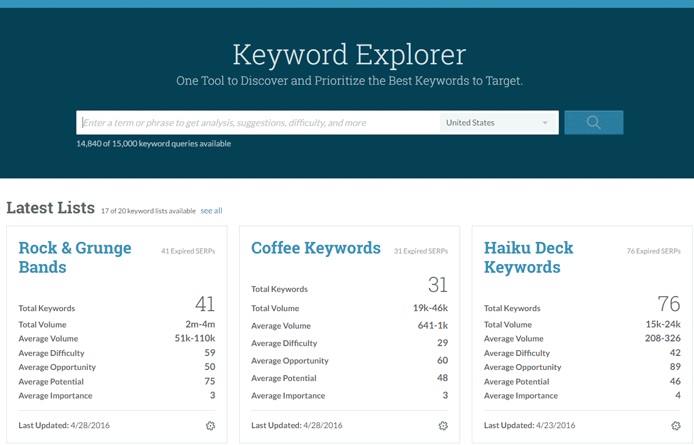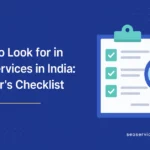Creating an effective keyword list takes time, effort, and focus. But it is one of the most important things you can do to help your business, agency, or customers be successful.
An effective keyword list will help you repeatedly rank on the first page of Google.
Whether your goal is getting more blog subscribers, demo requests, direct sales, or simply increasing brand awareness, ranking on the first page of Google is a tremendous achievement, and a key part of any SEO plan.
But regardless of your motives, the first step to ranking content is organizing your keyword research and prioritizing your best attempts into an organized keyword list.

What are the pros and cons of creating a keyword list?
This is an important question, since it not only takes effort to create your keyword list, but you’ll have to do additional work to keep the list updated over time.
Here are some benefits of using a keyword list:
- Use a keyword list to inform and map out an editorial calendar. If this is your first time creating an editorial calendar, don’t go too crazy. Just get started and map out the next one-to-two months. After that, map out the next three-to-six months. The hard part isn’t having enough ideas to fill up six months worth of blog posts and white papers. The hard part is coming up with ideas and keywords that get closer and closer to your audience, and what you want them to do. So start small and build a better content empire over time. (Progress, not perfection!)
- Use a keyword list to focus your content creation efforts. There are too many things to write about, only a few things that your audience cares about, and even fewer hours in the day. The keyword list will be your friend when it comes to working smarter and maximizing the impact of your work. The keyword list coupled with your editorial calendar will help estimate how much time you need to research one topic, and hopefully amplify that work over several pieces of content.
- Use the keyword list to get more out of existing content by helping you focus on backlinking and promoting. This is your opportunity to create a full list of what you’ve created and connect it to the keywords that you want to win. You may find that some of your content is already ranking for keywords on your list, which means your next task is to optimize the content and pitch it to blogs and social influencers, to help your work climb up the ever-important ranks of Google.
And here are some drawbacks of having a keyword list:
- Creating and managing a keyword list takes time and commitment. While it’s worth the exercise since it allows you to work smarter, creating and managing a keyword list does take time. My advice: Bite the bullet and set aside three or four hours to lay down the foundation for your keyword research and list. Once that’s out of the way, (and hopefully with the help of creative and supportive teammates) the rest of the list and prioritization will flow easily.
A keyword list might constrain you and narrow your content world. The keyword list is only representative of what you and your team are aware of — be it about a product, industry, or target audience. The danger of this is missing out on the wonderful universe of other content creators and experts that you’re not aware of. So keep yourself flexible, create space to stay creative, and be open to new ideas that don’t show up on your initial keyword list.
Now, let’s crack open a spreadsheet and jump into how to create and prioritize a keyword list.
Six Steps to Create and Prioritize a Keyword List
Step 1: Audience
In this tab, write down what you know about your buyers, what’s important to them and when, and important dates to track.
Your buyer (or whoever you consider to be your audience) should always be front and center during this exercise. If you already have personas mapped out to the typical sales cycle, refer back to that while you start writing categories of keywords.
If you’re still learning about your buyer, it’s a good idea to go through the classic persona exercise, but if you’re short on time and need to move quickly, you can do the following two things to put yourself in the shoes of your buyer:
- Get knowledge transferred from someone in a sales or product role. This person is likely 100% focused on what’s important to your target customer and will help you get closer to what’s true for your customer.
- Listen to sales calls. Sales calls and notes hold a wealth of information, and will allow you to pick up a lot of non-verbal queues as your target buyer engages directly with your team/product.
Move onto step 2 when you can answer these questions:
- Who is your buyer?
- What are you trying to convince them to do with your content?
Step 2: Categories of keywords
In this tab, write a list of topics that you want to dive into with specific keywords. You’ll end up transferring this list of categories to a keywords tab, so just treat this as your brainstorming section.
The result of this step will be a list of topics (or buckets of content) that represent:
- Intersections between your buyer and your product
- Areas where you or someone on your team is a product or industry expert
- Concerns that are important to your buyer and are at least tangentially related to your product
If your goal is lead generation, then create categories or topics that are right at the intersection of pain points and problems you’re trying to solve.
If your goal is broader (e.g. you want to use content for a longer play like thought leadership), layer in categories where you’re a subject matter expert and can lend true education on things your buyer cares about.
This can be a challenging exercise, so be easy on yourself. You’ll have the opportunity to go back and refine this list. Just let your imagination and ideas flow. The main thing to keep in mind is your buyer.
Step 3: Keyword list
In this tab, copy over your categories and start listing keywords that fit under each category. You should have multiple keywords per category (when possible).
Treat this step like step 2. The result of this step will be a list of actual keywords that you will try to win in specific pieces of content. While the names of categories may not explicitly show up in content, these keywords will. So phrases and longtail keywords should end up on this list.
While there are a ton of best practices out there to build a list of keywords, your brain is the best first place to start. Draw upon your own experience, instinct, and knowledge. Trust yourself in this process, and since it’s not the final product, this is a powerful moment to brainstorm. Again, you’ll have time to pare this down later.
Make this step more enjoyable and fruitful by working with a colleague. If you’re in marketing, work with someone in sales, customer success, or product. This will help you look at all parts of the funnel and create a keyword list that hits the entire customer lifecycle.
Once you get all of your thoughts out, start looking to SEO best practices to build up your keywords. Here are a few helpful articles:
Moz Beginners Guide to Keyword Research
Search Engine Land Keyword List Building 101
SEOBook Keyword List Generator
(Note: Tools to generate keywords are useful when you’re jumping into a product or industry where you have little firsthand knowledge. Use this to kickstart brainstorming and iterate, but don’t use this tool as a sole source of truth and innovation.)
Step 4: Check volume
- In the same keyword tab, create a column to track average monthly search volume.
- Sign into Google AdWords.
- Go to Keyword Planner under Tools.
- Go to Get Search Volume Data and Trends.
- Cut and paste your list of keywords.
- Adjust targeting.
- Download your results and update your keyword list.
If you’re just starting out and want to test the waters, look at keywords that get at least 50 average monthly searches, and tackle one of those. It might be easy to win, depending on the strength of the content on the first page of Google. And it feels great to get those first wins! It will really boost your confidence as you continue down the road of getting content to rank on Google.
Step 5: Relevance score
In the same keyword tab, create a column to give a relevance score to each keyword. Here’s your first step to prioritization.
Keep this simple, score from 1-3:
- words tab for links to existing content.
One of the greatest benefits of the keyword list is you can start getting more out of your existing content. You’ll want to see if you’re currently ranking for keywords or already have content you want to rank for those terms. You’ll be better able to optimize this content for one or even multiple keywords.
The goal here is to rank better, drive more traffic, a
- Score a “1” for keywords that are closest to your goal. If you sell boutique pet food, then the keyword for “best grain-free dog food” would score a “1”.
- Score a “2” for keywords that imply someone is taking action, but not necessarily looking for dog food. For example, a “2” might be “help dog lose weight” or “healthy diet for dog.”
- Score a “3” for keywords that are flat, not necessarily actionable, and more focused on education. Some examples are, “what is kibble” or “types of dog food.” The topic is relevant since you sell pet food, but there are too many reasons why a person might want to learn what is kibble and too many of them are not real buyers.
Step 6: Prioritize
Overall, prioritization will happen on three levels: buyer, volume, and “win-ability” (i.e. if you can’t beat what’s already ranking, then cut your losses and move on).
Prioritization can be thought of in two ways: existing keyword opportunities and new keyword opportunities.
Existing Keyword Opportunities
Add a column in the keywords eventually create more conversion off of existing content. There are a number of content optimization tools out there, including Mushi Labs, which will help score and give keyword suggestions based on analyzing content ranked on the first page of Google.
New Keyword Opportunities
Hopefully your keyword list has a healthy amount of existing content tied to it. Anything remaining are your new keyword opportunities.
New keyword opportunities come from a variety of sources: overlooked synonyms, the long-tail of existing high-value keywords, new feature releases, new products, etc. When considering new keywords to go after, keep in mind your buyer, volume, and win-ability (can you create high-value content that can reasonably beat some of the results on the first page of Google?).
The final step to prioritization is a combination of those same three things and the resources you have available. Remember that content is the key to ranking well. Sometimes you’ll find a keyword opportunity, but lack the right content. Other times, you’ll have content already and need to optimize it to rank higher for the right word. Prioritize your list based on what you can accomplish well, with what you already have.
Finally, if you’re using this to build out an editorial calendar and are running with a lean team, pull out five categories that are the most important (again based on buyer, volume, and win-ability). Create a separate tab for these five categories and start brainstorming with the team how to pump up existing content opportunities and tackle new content opportunities.
The beauty of a keyword list is it allows you to be more strategic and smarter with your time. Whether it’s getting more out of work you’ve already created or strategically going after important, winnable keywords to rank on the first page of Google, the keyword list will help you focus and get more disciplined in your content efforts.
CREDIT SOURCE
This article is wholly dedicated from ClickTime.com and we appreciate them sincerely.










